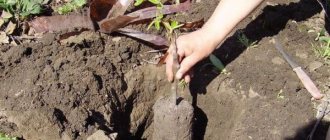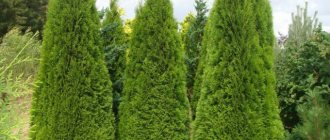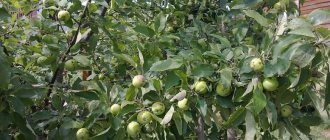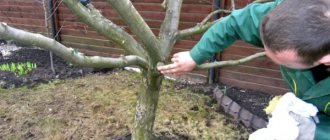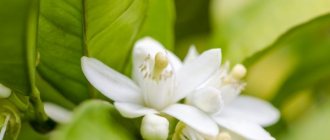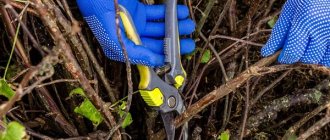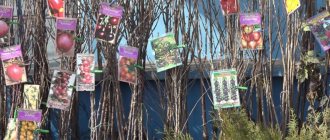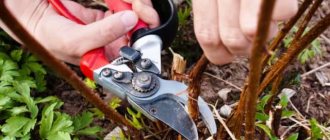The Mantet apple tree was developed by Canadian specialists. This summer variety turned out to be so successful in its main characteristics that it quickly became popular not only among Canadian farmers.
Gardeners from other countries of the world began to buy seedlings of this variety, including from Russia, where the variety was included in the State Register of the country and recommended for cultivation in the Central and Middle Volga regions.
History of the variety's creation
The Mantet variety was bred by Canadian breeders at the beginning of the second quarter of the last century as a result of cross-pollination of Mackintosh and Tetovsky apple trees (this name was given to the Russian variety Grushovka Moskovskaya in Canada). It is believed that the Canadian plant breeder Dr. W. T. Makoen was involved in developing the new variety.
Scientists, however, still disagree on which apple tree this variety actually originated from - from Grushovka or from Titovka. The fact is that in Canada Grushovka is called Tetovsky, but another Russian apple tree is also popular there - Titovka (translated as Titowka). Because of this, confusion arose as to which variety was cross-pollinated to produce the Mantet apple tree.
Is it suitable for the Moscow region?
The Mantet apple tree is included in the register of varieties suitable for cultivation in the Central region of Russia , which includes the Moscow region.
The Mantet apple tree is not highly winter-hardy and can freeze in particularly harsh winters .
How to minimize the risk of freezing:
- Select a seedling grown at a local nursery .
- For planting, choose a sunny place, avoiding lowlands and heavily windy areas.
- For the first three years, cover the seedling without winter.
Main characteristics
This fruit tree is medium-sized, its average height is 4-4.5 m. The shape of the crown is round or oval, the number of skeletal branches and shoots is average, so the crown is not thickened. The main shoots grow almost vertically.
The branches are geniculate, with brown bark. Lentils are small in size, gray in color. Young shoots and bark are not particularly strong; they become stronger with age. The skeletal branches are well leafed.
The foliage is large, leathery, with a characteristic shine, dark emerald color. The shape of the leaf plates is ellipsoidal, the tips are pointed. The veins are clearly visible, their color is soft green. The edges of the foliage are slightly wavy, finely serrated, slightly raised upward.
The ends of the leaves are directed upward. The shape of the stipules is awl-shaped, their size is small. The petioles are separated from the branches, larger than average in size, thickened, anthocyanin colored.
Leaf buds are cone-shaped, slightly pubescent, small in size, convex. The buds begin to bloom on this apple tree in the second ten days of May. The color of the large rounded petals is white-pink with a purple tint. The buds are collected in thyroid inflorescences. The pistils are small in size, the anthers are located above the stigmas.
The Mantet variety is early-bearing; young trees bear fruit in the 3rd season from the moment the fruit crop is planted in a permanent place.
Description of fruits
Ripe fruits are conical, round and slightly oblong. The ribbing is clearly visible in the upper part. The funnel has a regular shape, the stalks are often thickened, but thin ones are also found.
The mass of apples is 95-175 g. The peel is quite strong, of medium thickness, almost unnoticeable in food, smooth, with a characteristic shine. Its color at full maturity is bright yellow with a characteristic blush, either spots or vertical stripes.
The pulp is slightly compacted, with a lot of juice, homogeneous mass, white or cream color with a pinkish tint. The seed chambers are located approximately in the center of the fruit; the seeds are small and brown in color.
The taste of ripe fruits is good, the sweetish pulp with a slight sourness literally melts in the mouth. The smell of ripe apples is subtle, barely noticeable. The harvested crop tolerates transportation well over any distance, but the fruits are not stored for long - under room conditions, apples begin to spoil within a couple of weeks after picking, and they can be kept in the refrigerator for no more than a month.
These apples have a universal purpose; thanks to their dessert taste, they are used for food, in cooking, for making preserves and jams, and for extracting juices. The fruits contain a lot of sugars, so you can add less sugar to jams when cooking. The fruits can also be dried.
The resistance of this variety to cold is low - the trees begin to freeze when the temperature drops to 15-16 degrees Celsius. Therefore, in regions with cold winters, these trees require good shelter before the onset of frost.
Pollinator trees
If the weather is cold and rainy during flowering, the variety may not self-pollinate well. Therefore, other apple trees are simultaneously planted next to the Mantet variety for better cross-pollination.
The best pollinators for this apple tree are:
- Melba;
- White filling;
- Melba Ed.
Melba
White filling
Melba Red
If there are no pollinating trees nearby, then rainy weather at the time of flowering of the Mantet apple tree will cause too low yields.
Productivity
Flowering occurs mainly on ringlets. In the Volga region and in more southern regions, apples ripen in the second ten days of July. In areas with cooler climates, harvesting begins in the last ten days of July or the first ten days of August.
The harvest may last until the first ten days of September. From 25 to 63 kg of ripe apples are collected from young trees. Mature fruit trees can produce up to 72-75 kg with proper care.
If the Mantet variety is well cared for, the apple tree will bear stable annual fruit for at least 50 years.
Diseases and pests
The Mantet apple tree is characterized by low resistance to plow, especially the foliage suffers from this disease; ripe fruits are less susceptible to this disease. Therefore, it is necessary to periodically spray the aerial parts of these fruit trees with fungicide solutions, especially during rainy seasons.
In the autumn, after leaf fall, it is necessary to remove and burn all fallen leaves from the tree trunks, as well as plant debris. The most common pests that damage the Mantet apple tree are leaf rollers and apple flower beetles.
Advantages and disadvantages
The main advantages of the Mantet apple tree include:
- the crown is compact and sparse, so this apple tree can be grown in small garden plots;
- around these apple trees you can plant fruit bushes, strawberries, vegetables, and flowers;
- This fruit tree does not need regular pruning and crown formation;
- Thanks to the dense skin, the harvested crop can easily be transported over any distance;
- Thanks to the sweet taste, you can add less sugar when preparing preparations from apples of this variety.
But this apple tree also has a number of disadvantages that gardeners need to know about:
- the shoots grow vertically, making it more difficult to pick ripe apples from the tree;
- from about 12-13 years old, the tree begins to bear fruit less consistently, good harvests are repeated every 2 seasons;
- high yields directly depend on the weather and the presence of nearby pollinators;
- Supports should be placed under young shoots so that they do not break off under the weight of ripening fruits;
- if the harvest is plentiful, then the apples may become smaller;
- it is difficult to trim the top part of the tree, which can lead to the development of diseases or an increase in the number of pests;
- low resistance to many diseases and pests;
- low resistance to cold;
- During the rainy season, there is a high probability of the tree being damaged by scab of leaves and fruits.
Advantages and disadvantages
The advantages and disadvantages include:
- The sparse, neat crown of Manteta does not require close attention.
- The plant is not whimsical in choosing its neighbors; flowers and vegetables can be planted next to it.
- Apple trees of other varieties, with which Mantet has the same flowering period, only improve the yield of the self-fertile variety.
- The fruits are delicious.
- After 10-11 fertile seasons, the apple tree will delight you with a rich harvest in a year.
- The presence of apple pollinators and favorable weather conditions greatly influence the quality of the harvest.
- Uneven ripening of fruits.
- Young, immature branches of the apple tree break under the weight of the fruit.
- The higher the harvest, the smaller the fruits.
- Weak immunity to diseases and attractive to pests.
- Low winter hardiness.
- During rainy seasons, the likelihood of scab infection increases.
Landing
It is better not to plant seedlings of this variety in the autumn in regions with cold winters, since its resistance to cold is low, so the tree may not have time to grow stronger and will freeze in winter.
Young trees are planted in the first or second ten days of April. The planting site should be well lit by sunlight, protected from gusts of wind, and the soil should be loose and fairly fertile.
Excessive soil moisture is harmful to this apple tree and can cause root rot in this fruit tree. Therefore, it should not be planted in lowlands or in areas where groundwater comes too close to the surface of the earth (closer than 3.0 m).
The seedlings must be two years old, the length of the root system is at least 0.25 m, and the crown consists of 3-5 branches with a length of at least 0.5 m. The root system and shoots must not have visible damage or traces of disease
The pit for planting is prepared 10-12 days in advance. Its diameter should be 0.9-1.1 m, and its depth should be 0.85-0.9 m. The top soil removed from the pit is mixed with 30 kg of humus, 1000 g of wood soil, 1 cup of potassium sulfate and 2.5 cups superphosphate. Fill the hole about 2/3 with this nutrient substrate, pour a layer of garden soil on top and water it so that the mixture settles. You need to pour 10 liters of water into each hole.
A wooden support is driven in near the center of the hole to secure the seedling after planting. The seedling is placed in the center of the hole, the roots are straightened and the hole is filled with soil. The root collar should be 6-7 cm above the soil level.
Then it is compacted and the plants are watered again. At least 30 liters of water must be poured under each tree. After the water is absorbed, the tree trunk circle is mulched with rotted sawdust or hay.
Description of the Mantet apple tree
If we make a detailed description of the Mantet apple tree variety, we need to mention that it has an average size of 4 - 5 meters, has a small oval crown and strong thin branches that look up. The tree is covered with large, embossed, green elliptical leaves. Most fruits are found on the ringlets. They are medium in size: weighing no more than 130 grams. The main color of the fruit is yellow and green with a slight blush. The skin is thin. Beneath it is a delicious white dessert pulp.
Important! The variety is not recommended for planting in the north of the country. It is suitable for cultivation in the center, south and central part of Russia.
Care
Further care for this apple tree consists of periodic watering, fertilizing, sanitary pruning and preparing the trees for the winter season. When watering, you need to remember that waterlogging and drought are harmful to this tree, so the soil should be moderately moist after watering.
For mature Mantet apple trees, you need to add at least 6-7 buckets of water during watering; later, the volume of watering is doubled.
Watering scheme for this apple tree per season:
- if the spring is dry, then the first watering is done before the buds appear;
- The trees are watered for the second time in the second decade of June;
- During the ripening of apples, you need to water the apple trees again;
- in the second ten days of October, moisture-charging irrigation is carried out.
After each fall/willow, you need to loosen the tree trunk circles and at the same time remove all plant debris and weeds. Then mulch the soil with organic matter.
Feeding
Fertilization is an important stage in the life of this apple tree. It needs nutrients for active growth of above-ground and underground parts, abundant flowering and fruiting. In the second ten days of April, at least 500 g of dry urea is scattered under each tree, and slurry is poured on top. 30 liters of this fertilizer are poured under young apple trees, and up to 100 liters under adult trees.
After digging, the tree trunk circles are covered with humus or compost.
In the second decade of May, the following solution is added to the tree trunk circles: 100 g of potassium sulfate, 600 g of superphosphate, 1 liter of liquid chicken manure, 2 liters of slurry are diluted in 20 liters of water. For young apple trees, it is enough to apply 1 liter of this fertilizer, for adults – 50 liters.
After watering, 600 g of urea should be scattered around the tree.
In the second decade of July, the following solution is prepared for feeding an adult tree: 600 g of nitrophoska and 5 g of sodium humate are diluted in 20 liters of water. The resulting fertilizer is poured into the trunk circle of one tree.
At the end of September, 350 g of potassium sulfate and superphosphate are scattered under the apple tree.
Trimming
These trees need to be pruned three times during the summer - in the last ten days of March, in the summer they pinch and break out excess shoots, in the fall after the leaves fall. This apple tree usually has a three-tiered crown. In the first tier only the three strongest branches are left, in the second - 4, and in the last - 2.
When carrying out sanitary pruning, all damaged, dried out and diseased shoots are removed. If the branches grow too rapidly, they need to be shortened so that the shape of the crown remains round. All cut areas must be covered with garden varnish.
Preparing for winter
To protect the lower part of the central trunk from rodents, you need to whiten it and the base of the branches with a solution of lime, to which clay and copper sulfate have been added. To protect against frost, the apple tree trunk is wrapped in burlap, or spruce branches, reeds, and corn stalks are secured to it.
To protect the root system from the cold, the tree trunk circle is covered with mulch (earth or snow), the thickness of such a layer should be at least 30-35 cm.
Reviews
Olga, 45 years old, Volgograd region : I have known this variety for many years. My grandfather also planted a Mantet apple tree in our garden. And for decades now, the tree has been pleasing us with delicious, sweet apples, of which there are sufficient quantities. True, over the years, Mantet began to bear fruit after a season, but the harvest produces so many preparations that it lasts for a couple of years.
Kristina, 50 years old, Saratov region : apples of this variety are among the first to appear in our garden. True, they have a disadvantage - they are not stored for more than 12-14 days, but we have time to eat plenty of them and make various preparations. Most of all, my family likes the juice from these fruits, jam and marshmallows. It’s good that in our climate this tree practically does not freeze in winter.
Olga, 40 years old, Krasnodar region : this apple tree is classified as an early variety; in our region, ripe fruits ripen at the end of July. In the first seasons, the amount of harvest increases exponentially, but by the age of 12-13, the Mantet apple tree most often bears fruit once every 2 seasons. But in a fertile year, we remove part of the ovaries in order to reduce the load on the tree with the harvest; as a result, next year we manage to remove 30-35 kg of apples, sometimes more.
Commodity and consumer qualities of apples
The fruits are large, one-dimensional, weighing on average 140-180 g, regular round-conical shape, sometimes slightly beveled, with a slightly ribbed surface. The skin is dry, smooth, shiny. The main color is green, the outer color is dark red with a purple tint, blurry. Subcutaneous dots are gray, small, barely noticeable; funnel without rust.
Apples have almost the same shape and size, attractive presentation
The pulp is juicy, greenish-cream color, medium density, prickly, crispy, sweet and sour. Professional tasters evaluate taste on a 5-point scale of 4.2-5.0 points. Pronounced sweetness is harmoniously combined with light sourness, which adds freshness to the fruit. The aroma is weak, which many gardeners consider a significant disadvantage.
According to the results of field tests and laboratory studies conducted by VNIISKP specialists in the Oryol region, the fruits are characterized by a balanced taste (sugar acid index 18.7-21.1) and are not inferior to “Antonovka ordinary” in terms of the amount of vitamin C. The biochemical composition contains (according to the originator and Russian scientists):
| Nutrients and beneficial substances | Quantity per 100 g of product |
| Vitamin C (ascorbic acid) | 8.7-17 mg |
| Sahara | 10.9-20 g |
| Dry matter | 11.7-22 g |
The flavor of apples picked in the fall fully develops towards the end of winter. Consumption period February – April. When properly stored, the fruits do not lose their taste and consumer properties until the next harvest.
The fruits are in demand in the industrial production of juices, cider and other apple products
Apples of the “Imant” variety are considered dessert apples, excellent for both fresh consumption and various processing methods. Due to their low acidity and pronounced sweetness, they make good cider, jam and marshmallows.
